Fabrication of Amine-Modified Magnetite-Electrochemically Reduced Graphene Oxide Nanocomposite Modified Glassy Carbon Electrode for Sensitive Dopamine Determination
Abstract
:1. Introduction
2. Experimental Section
2.1. Materials and Chemicals
2.2. Synthesis of NH2–Fe3O4 NPs
2.3. Synthesis of NH2–Fe3O4/GO Nanocomposites
2.4. Fabrication of NH2–Fe3O4/RGO/ GCE
2.5. Characterization
2.6. Electrochemical Experiments
2.7. Analysis of Real Samples
3. Result and Discussion
3.1. Optimization of Electrochemical Reduction Conditions
3.2. Characterization of NH2–Fe3O4/RGO Nanocomposites
3.3. Electrochemical Active Area
3.4. The Electrochemical Behavior of Modified Electrodes
3.5. Optimization of the Detection Conditions of DA
3.5.1. The Influence of pH Value
3.5.2. The Influence of Scan Rate
3.5.3. Effect of Accumulation Potential and Time
3.6. Interference Studies
3.7. Calibration Curve, Linear Range and Detection Limit
3.8. Analysis of Real Samples
4. Conclusions
Acknowledgments
Author Contributions
Conflicts of Interest
References
- Liu, A.; Honma, I.; Zhou, H. Simultaneous voltammetric detection of dopamine and uric acid at their physiological level in the presence of ascorbic acid using poly(acrylic acid)-multiwalled carbon-nanotube composite-covered glassy-carbon electrode. Biosens. Bioelectron. 2007, 23, 74–80. [Google Scholar] [CrossRef] [PubMed]
- Liu, A.; Honma, I.; Zhou, H. Amperometric biosensor based on tyrosinase-conjugated polysacchride hybrid film: Selective determination of nanomolar neurotransmitters metabolite of 3, 4-dihydroxyphenylacetic acid (DOPAC) in biological fluid. Biosens. Bioelectron. 2005, 21, 809–816. [Google Scholar] [CrossRef] [PubMed]
- He, Q.; Liu, J.; Liang, J.; Liu, X.; Li, W.; Liu, Z.; Ding, Z.; Tuo, D. Towards improvements for penetrating the blood–brain barrier—recent progress from a material and pharmaceutical perspective. Cells 2018, 7, 24. [Google Scholar] [CrossRef] [PubMed]
- Zhou, Y.; Yan, H.; Xie, Q.; Huang, S.; Liu, J.; Li, Z.; Ma, M.; Yao, S. Simultaneous analysis of dopamine and homovanillic acid by high-performance liquid chromatography with wall-jet/thin-layer electrochemical detection. Analyst 2013, 138, 7246–7253. [Google Scholar] [CrossRef] [PubMed]
- Lin, L.; Qiu, P.; Yang, L.; Cao, X.; Jin, L. Determination of dopamine in rat striatum by microdialysis and high-performance liquid chromatography with electrochemical detection on a functionalized multi-wall carbon nanotube electrode. Anal. Bioanal. Chem. 2006, 384, 1308–1313. [Google Scholar] [CrossRef] [PubMed]
- Hows, M.E.; Lacroix, L.; Heidbreder, C.; Organ, A.J.; Shah, A.J. High-performance liquid chromatography/tandem mass spectrometric assay for the simultaneous measurement of dopamine, norepinephrine, 5-hydroxytryptamine and cocaine in biological samples. J. Neurosci. Methods 2004, 138, 123–132. [Google Scholar] [CrossRef] [PubMed]
- Govindaraju, S.; Ankireddy, S.R.; Viswanath, B.; Kim, J.; Yun, K. Fluorescent gold nanoclusters for selective detection of dopamine in cerebrospinal fluid. Sci. Rep. 2017, 7, 40298. [Google Scholar] [CrossRef] [PubMed]
- Chibac, A.L.; Melinte, V.; Buruiana, T.; Buruiana, T.; Buruiana, E.C. Fluorescent polymeric sensors containing boronic acid derivatives for sugars and dopamine detection: Sensing characteristics enhancement by Au NPs. Sens. Actuators B 2017, 253, 987–998. [Google Scholar] [CrossRef]
- Wu, B.; Miao, C.; Yu, L.; Wang, Z.; Huang, C.; Jia, N. Sensitive electrochemiluminescence sensor based on ordered mesoporous carbon composite film for dopamine. Sens. Actuators B 2014, 195, 22–27. [Google Scholar] [CrossRef]
- Zhang, L.; Cheng, Y.; Lei, J.; Liu, Y.; Hao, Q.; Ju, H. Stepwise chemical reaction strategy for highly sensitive electrochemiluminescent detection of dopamine. Anal. Chem. 2013, 85, 8001–8007. [Google Scholar] [CrossRef] [PubMed]
- Ensafi, A.A.; Taei, M.; Khayamian, T.; Arabzadeh, A. Highly selective determination of ascorbic acid, dopamine, and uric acid by differential pulse voltammetry using poly(sulfonazo III) modified glassy carbon electrode. Sens. Actuators B 2010, 147, 213–221. [Google Scholar] [CrossRef]
- Revin, S.B.; John, S.A. Highly sensitive determination of uric acid in the presence of major interferents using a conducting polymer film modified electrode. Bioelectrochemistry 2012, 88, 22–29. [Google Scholar] [CrossRef] [PubMed]
- Ciszewski, A.; Milczarek, G. Polyeugenol-Modified Platinum Electrode for Selective Detection of Dopamine in the Presence of Ascorbic Acid. Anal. Chem. 1999, 71, 1055–1061. [Google Scholar] [CrossRef] [PubMed]
- Feng, X.; Mao, C.; Yang, G.; Hou, W.; Zhu, J. Polyaniline/Au Composite Hollow Spheres: Synthesis, Characterization, and Application to the Detection of Dopamine. Langmuir 2006, 22, 4384–4389. [Google Scholar] [CrossRef] [PubMed]
- Shams, E.; Babaei, A.; Taheri, A.R.; Kooshki, M. Voltammetric determination of dopamine at a zirconium phosphated silica gel modified carbon paste electrode. Bioelectrochemistry 2009, 75, 83–88. [Google Scholar] [CrossRef] [PubMed]
- Zare, H.R.; Sobhani, Z.; Mazloum-Ardakani, M. Electrochemical behavior of electrodeposited rutin film on a multi-wall carbon nanotubes modified glassy carbon electrode. Improvement of the electrochemical reversibility and its application as a hydrazine sensor. J. Solid State Electrochem. 2006, 11, 971–979. [Google Scholar] [CrossRef]
- Liu, Y.; Huang, J.; Hou, H.; You, T. Simultaneous determination of dopamine, ascorbic acid and uric acid with electrospun carbon nanofibers modified electrode. Electrochem. Commun. 2008, 10, 1431–1434. [Google Scholar] [CrossRef]
- Wen, J.; Zhou, L.; Jin, L.; Cao, X.; Ye, B. Overoxidized polypyrrole/multi-walled carbon nanotubes composite modified electrode for in vivo liquid chromatography–electrochemical detection of dopamine. J. Chromatogr. B 2009, 877, 1793–1798. [Google Scholar] [CrossRef] [PubMed]
- He, Q.; Liu, J.; Huang, C.; Wu, W. Synthesis and Characterization of a Silver Incorporated Magnetic Nanocomposite with Enhanced Antibacterial Activity. Sci. Adv. Mater. 2014, 6, 366–376. [Google Scholar] [CrossRef]
- He, Q.; Liu, J.; Huang, C.; Wu, Z. A nanoscale system for remarkably enhanced drug delivery based on hollow magnetic particles encapsulated within temperature-responsive poly(methylmethacrylate). Sci. Adv. Mater. 2014, 6, 387–398. [Google Scholar] [CrossRef]
- Liu, J.; Huang, C.; He, Q. Pharmaceutical application of magnetic iron oxide nanoparticles. Sci. Adv. Mater. 2015, 7, 672–685. [Google Scholar] [CrossRef]
- He, Q.; Liu, J.; Liang, J.; Liu, X.; Tuo, D.; Li, W. Chemically Surface Tunable Solubility Parameter for Controllable Drug Delivery—An Example and Perspective from Hollow PAA-Coated Magnetite Nanoparticles with R6G Model Drug. Materials 2018, 11, 247. [Google Scholar] [CrossRef] [PubMed]
- He, Q.; Liu, J.; Liang, J.; Liu, X.; Ding, Z.; Tuo, D.; Li, W. Sodium Acetate Orientated Hollow/ Mesoporous Magnetite Nanoparticles: Facile Synthesis, Characterization and Formation Mechanism. Appl. Sci. 2018, 8, 292. [Google Scholar] [CrossRef]
- Wu, D.; Li, Y.; Zhang, Y.; Wang, P.; Wei, Q.; Du, B. Sensitive electrochemical sensor for simultaneous determination of dopamine, ascorbic acid, and uric acid enhanced by amino-group functionalized mesoporous Fe3O4@graphene sheets. Electrochim. Acta 2014, 116, 244–249. [Google Scholar] [CrossRef]
- Chen, R.; Song, G.; Wei, Y. Synthesis of variable-sized Fe3O4 nanocrystals by visible light irradiation at room temperature. J. Phys. Chem. C 2010, 114, 13409–13413. [Google Scholar] [CrossRef]
- Ye, Y.; Kong, T.; Yu, X.; Wu, Y.; Zhang, K.; Wang, X. Enhanced nonenzymatic hydrogen peroxide sensing with reduced graphene oxide/ferroferric oxide nanocomposites. Talanta 2012, 89, 417–421. [Google Scholar] [CrossRef] [PubMed]
- Compton, O.C.; Nguyen, S.T. Graphene oxide, Highly reduced graphene oxide, and graphene: Versatile building blocks for carbon-based materials. Small 2010, 6, 711–723. [Google Scholar] [CrossRef] [PubMed]
- Rani, G.J.; Babu, K.J.; Gnana kumar, G.; Rajan, M.A.J. Watsonia meriana flower like Fe3O4/reduced graphene oxide nanocomposite for the highly sensitive and selective electrochemical sensing of dopamine. J. Alloys Compd. 2016, 688, 500–512. [Google Scholar] [CrossRef]
- Wang, Y.; Zhang, H.; Yao, D.; Pu, J.; Zhang, Y.; Gao, X.; Sun, Y. Direct electrochemistry of hemoglobin on graphene/Fe3O4 nanocomposite-modified glass carbon electrode and its sensitive detection for hydrogen peroxide. J. Solid State Electrochem. 2013, 17, 881–887. [Google Scholar] [CrossRef]
- Rocha-Santos, T.A.P. Sensors and biosensors based on magnetic nanoparticles. Trends Anal. Chem. 2014, 62, 28–36. [Google Scholar] [CrossRef]
- Wang, Y.; Liu, Q.; Qi, Q.; Ding, J.; Gao, X.; Zhang, Y.; Sun, Y. Electrocatalytic oxidation and detection of N-acetylcysteine based on magnetite/reduced graphene oxide composite-modified glassy carbon electrode. Electrochim. Acta 2013, 111, 31–40. [Google Scholar] [CrossRef]
- Xin, X.; Wei, Q.; Yang, J.; Yan, L.; Feng, R.; Chen, G.; Du, B.; Li, H. Highly efficient removal of heavy metal ions by amine-functionalized mesoporous Fe3O4 nanoparticles. Chem. Eng. J. 2012, 184, 132–140. [Google Scholar] [CrossRef]
- Chang, Y.; Ren, C.; Qu, J.; Qu, J.; Chen, X. Preparation and characterization of Fe3O4 /graphene nanocomposite and investigation of its adsorption performance for aniline and p-chloroaniline. Appl. Surf. Sci. 2012, 261, 504–509. [Google Scholar] [CrossRef]
- Sun, X.; Yang, L.; Li, Q.; Zhao, J.; Li, X.; Wang, X.; Liu, H. Amino-functionalized magnetic cellulose nanocomposite as adsorbent for removal of Cr(VI): Synthesis and adsorption studies. Chem. Eng. J. 2014, 241, 175–183. [Google Scholar] [CrossRef]
- He, Q.; Liu, J.; Liu, X.; Li, G.; Deng, P.; Liang, J. Preparation of Cu2O-reduced graphene nanocomposite modified electrodes towards ultrasensitive dopamine detection. Sensors 2018, 18, 199. [Google Scholar] [CrossRef] [PubMed]
- Dreyer, D.R.; Park, S.; Bielawski, C.W.; Ruoff, R.S. The chemistry of graphene oxide. Chem. Soc. Rev. 2010, 39, 228–240. [Google Scholar] [CrossRef] [PubMed]
- Guo, H.L.; Wang, X.F.; Qian, Q.Y.; Wang, F.B.; Xia, X.H. A green approach to the synthesis of graphene nanosheets. ACS Nano 2009, 3, 2653–2659. [Google Scholar] [CrossRef] [PubMed]
- Xiong, H.; Jin, B. The electrochemical behavior of AA and DA on graphene oxide modified electrodes containing various content of oxygen functional groups. J. Electroanal. Chem. 2011, 661, 77–83. [Google Scholar] [CrossRef]
- Deng, P.; Fei, J.; Feng, Y. Sensitive voltammetric determination of tryptophan using an acetylene black paste electrode modified with a Schiff’s base derivative of chitosan. Analyst 2011, 136, 5211–5217. [Google Scholar] [CrossRef] [PubMed]
- Hummers, J.W.S.; Offeman, R.E. Preparation of graphitic oxide. J. Am. Chem. Soc. 1958, 80, 1339. [Google Scholar] [CrossRef]
- Pei, S.; Cheng, H.M. The reduction of graphene oxide. Carbon 2012, 50, 3210–3218. [Google Scholar] [CrossRef]
- Sivasubramanian, R.; Biji, P. Preparation of copper (I) oxide nanohexagon decorated reduced graphene oxide nanocomposite and its application in electrochemical sensing of dopamine. Mater. Sci. Eng. B 2016, 210, 10–18. [Google Scholar] [CrossRef]
- Bard, A.J.; Faulkner, L.R. Electrochem Methods: Fundamentals and Application, 2nd ed.; Wiley: Hoboken, NJ, USA, 2000. [Google Scholar]
- Gooding, J.; Praig, V.; Hall, E. Platinum-catalyzed enzyme electrodes immobilized on gold using self-assembled layers. Anal. Chem. 1998, 70, 2396–2402. [Google Scholar] [CrossRef] [PubMed]
- Deng, P.; Xu, Z.; Kuang, Y. Electrochemically reduced graphene oxide modified acetylene black paste electrode for the sensitive determination of bisphenol A. J. Electroanal. Chem. 2013, 707, 7–14. [Google Scholar] [CrossRef]
- Laviron, E. General expression of the linear potential sweep voltammogram in the case of diffusionless electrochemical systems. J. Electroanal. Chem. Interfacial Electrochem. 1979, 101, 19–28. [Google Scholar] [CrossRef]
- Palanisamy, S.; Thirumalraj, B.; Chen, S.M. Palladium nanoparticles decorated on activated fullerene modified screen printed carbon electrode for enhanced electrochemical sensing of dopamine. J. Colloid Interf. Sci. 2015, 448, 251–256. [Google Scholar] [CrossRef] [PubMed]
- Liu, M.; Chen, Q.; Lai, C.; Zhang, Y.; Deng, J.; Li, H.; Yao, S. A double signal amplification platform for ultrasensitive and simultaneous detection of ascorbic acid, dopamine, uric acid and acetaminophen based on a nanocomposite of ferrocene thiolate stabilized Fe3O4@Au nanoparticles with graphene sheet. Biosens. Bioelectron. 2013, 48, 75–81. [Google Scholar] [CrossRef] [PubMed]
- Bagheri, H.; Afkhami, A.; Hashemi, P.; Ghanei, M. Simultaneous and sensitive determination of melatonin and dopamine with Fe3O4 nanoparticle-decorated reduced graphene oxide modified electrode. RSC Adv. 2015, 5, 21659–21669. [Google Scholar] [CrossRef]
- Cheemalapati, S.; Palanisamy, S.; Mani, V.; Chen, S.M. Simultaneous electrochemical determination of dopamine and paracetamol on multiwalled carbon nanotubes/graphene oxide nanocomposite-modified glassy carbon electrode. Talanta 2013, 117, 297–304. [Google Scholar] [CrossRef] [PubMed]
- Yao, Z.; Yang, X.; Niu, Y.; Wu, F.; Hu, Y.; Yang, Y. Voltammetric dopamine sensor based on a gold electrode modified with reduced graphene oxide and Mn3O4 on gold nanoparticles. Microchim. Acta 2017, 184, 2081–2088. [Google Scholar] [CrossRef]
- He, Q.; Liang, J.; Li, G.; Deng, P.; Liu, J.; Liu, X. Electrochemical detection of dopamine based on MnO2 nanowires/reduced graphene oxide composites modified glassy carbon electrode. Chinese J Anal. Chem. 2018, 46, 438–445. [Google Scholar]
- Wang, Z.; Tang, J.; Zhang, F. Elimination of ascorbic acid and sensitive detection of uric acid at the MnO2 nanorods/graphene-based modified electrode. Int. J. Electrochem. Sci. 2013, 2031, 9967–9976. [Google Scholar]
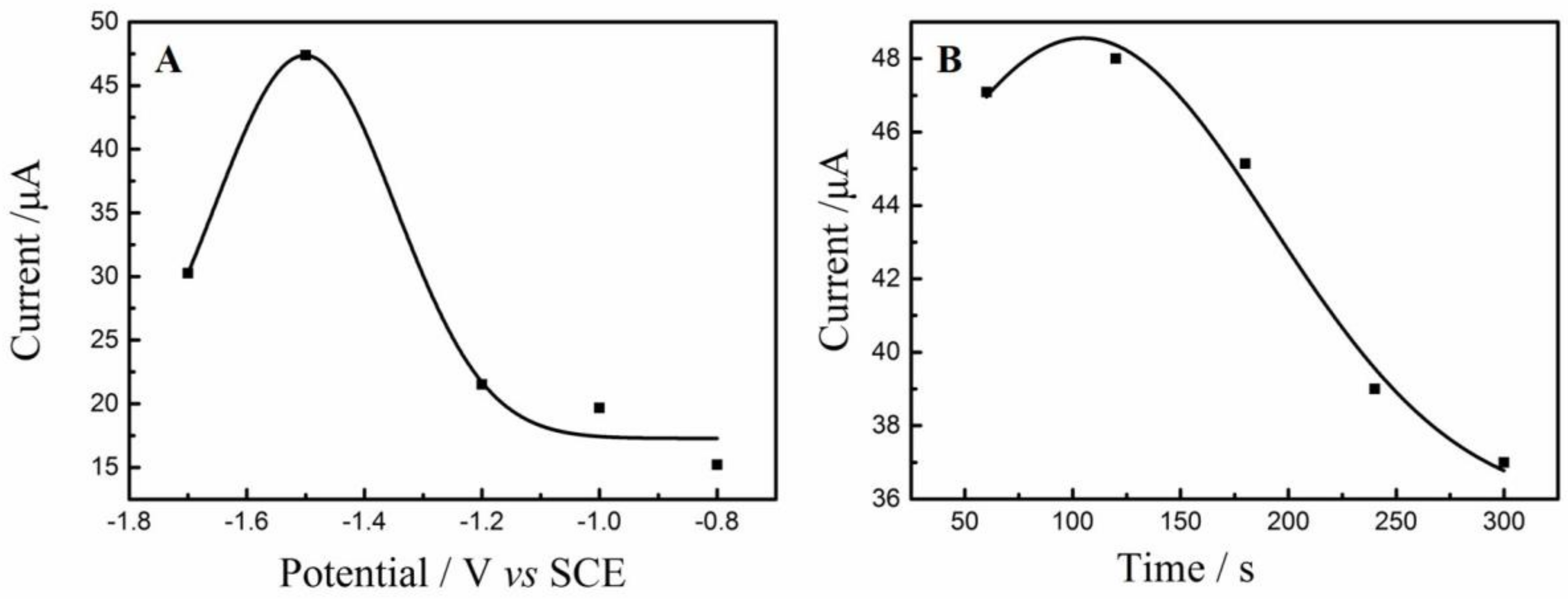
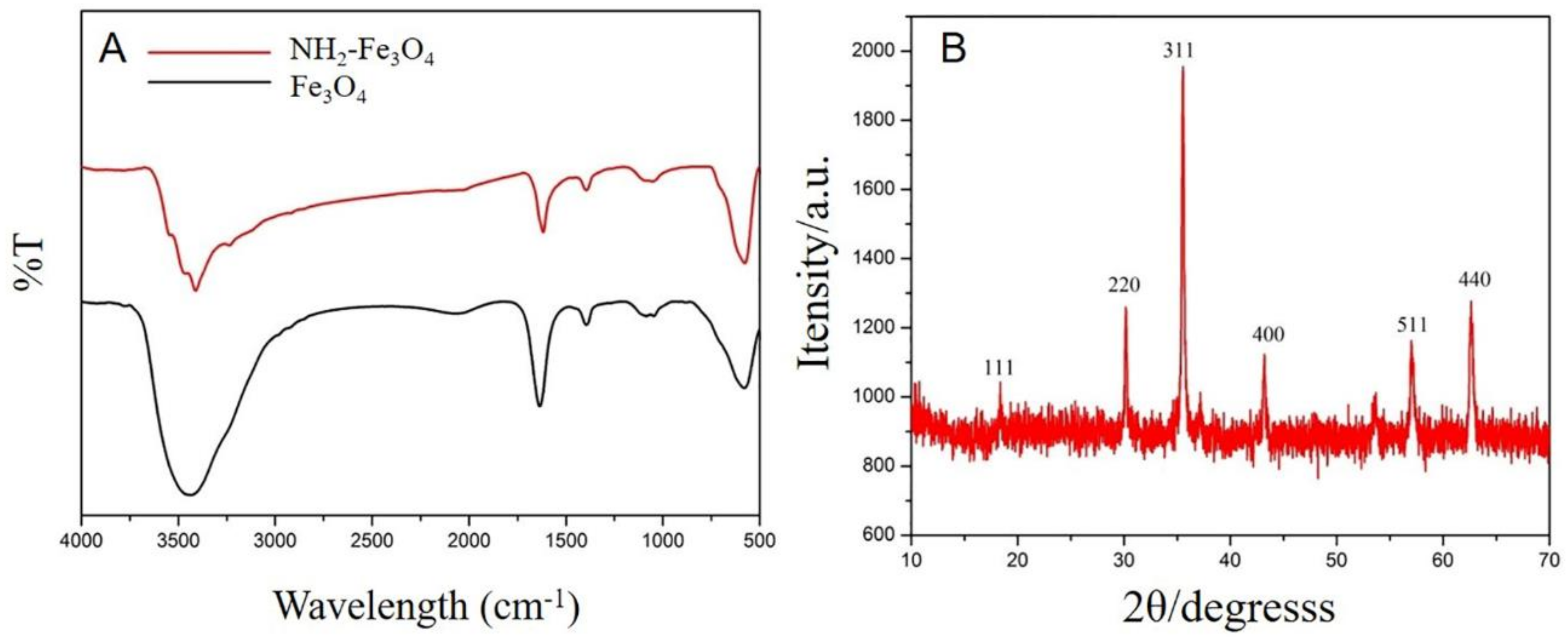
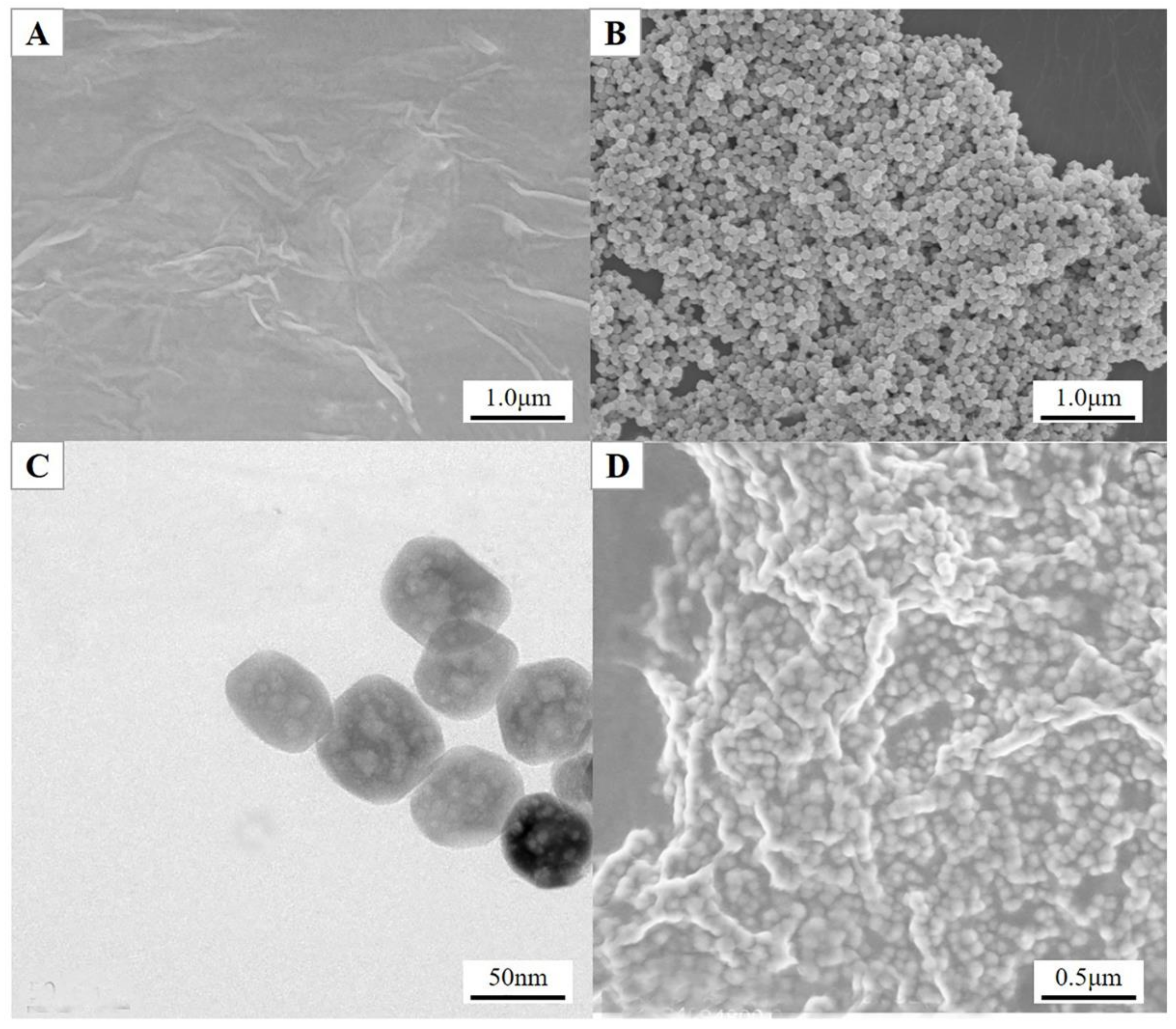
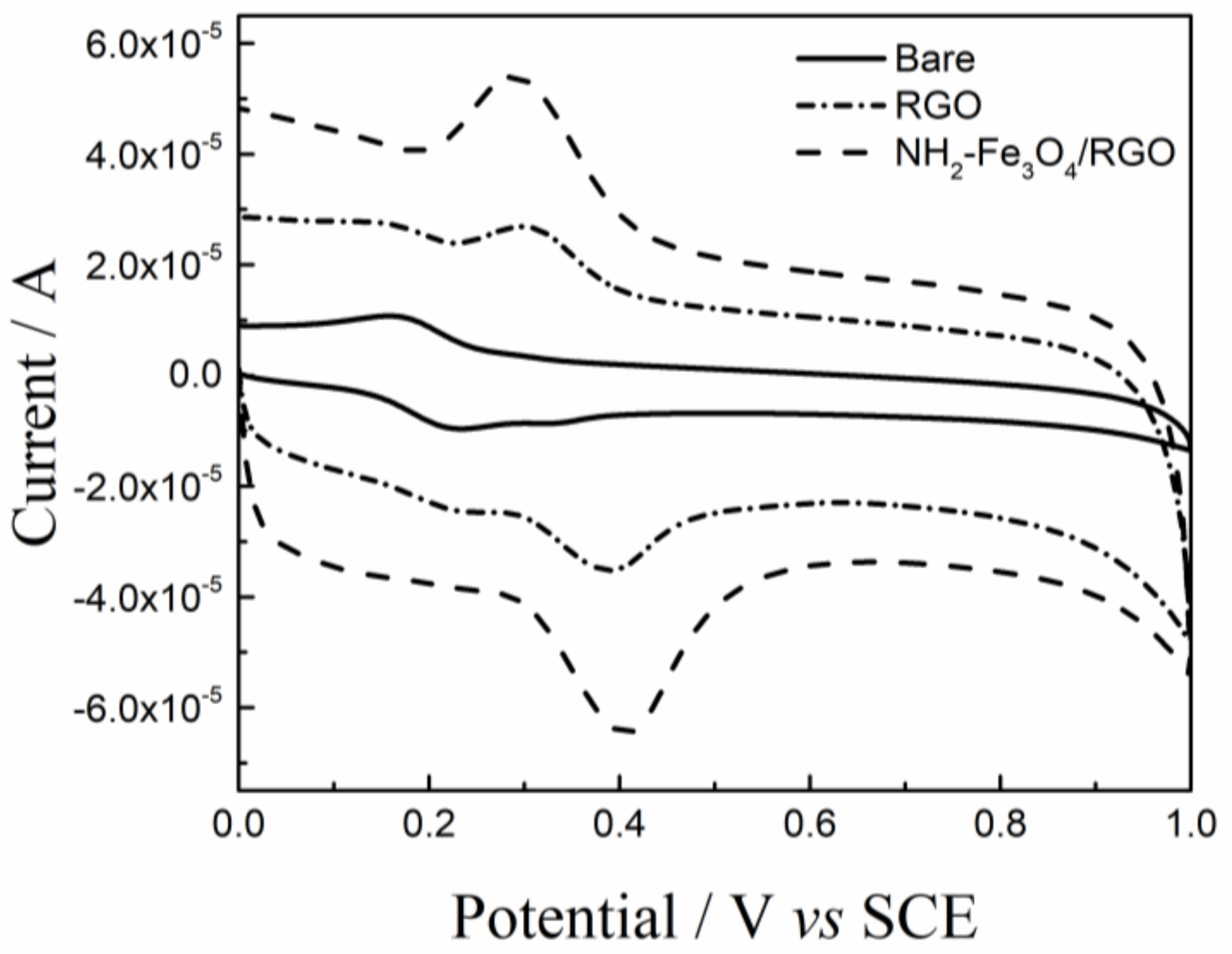

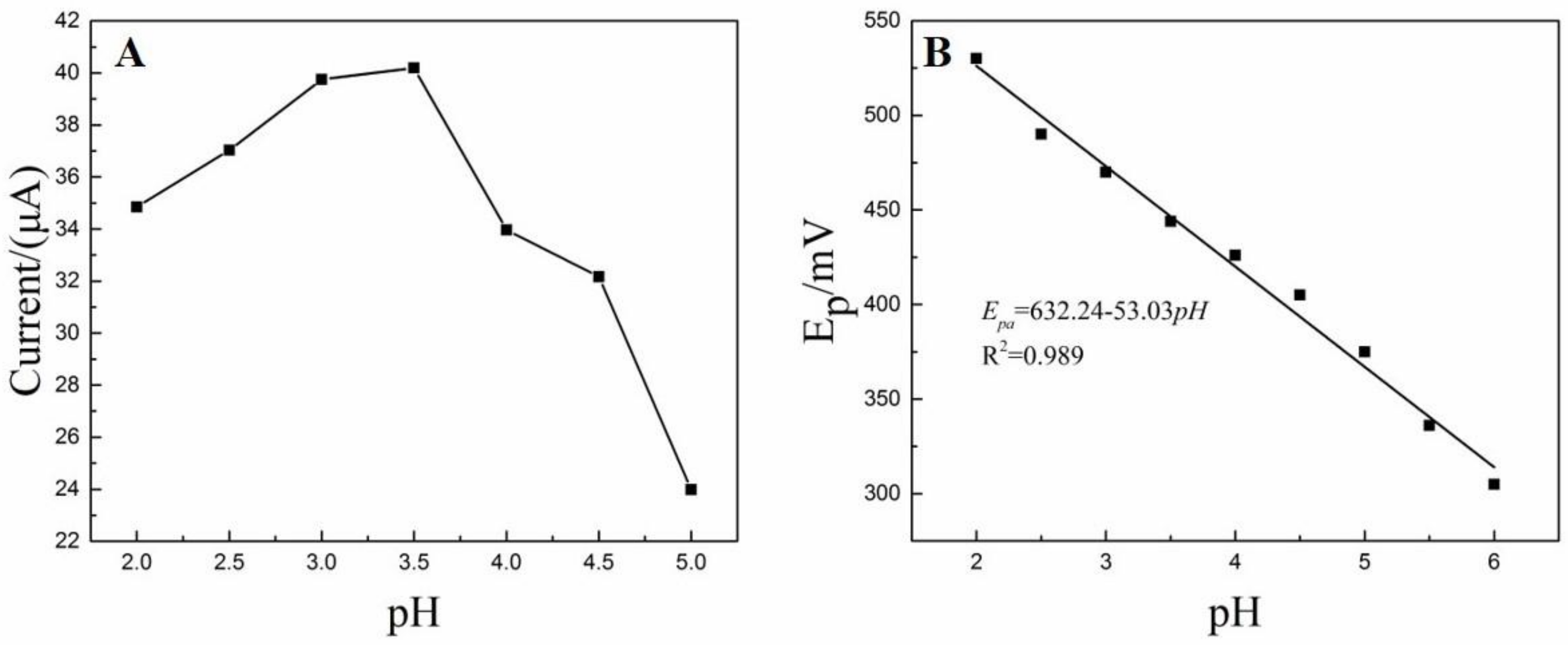


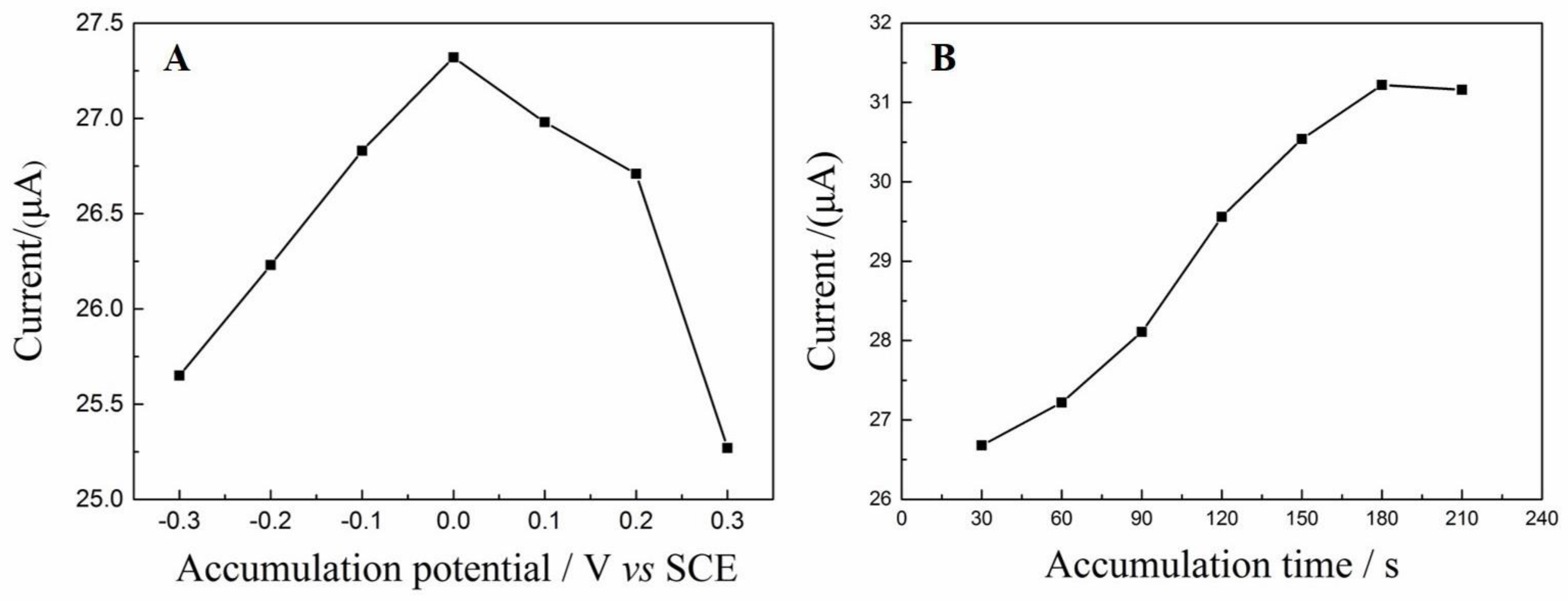
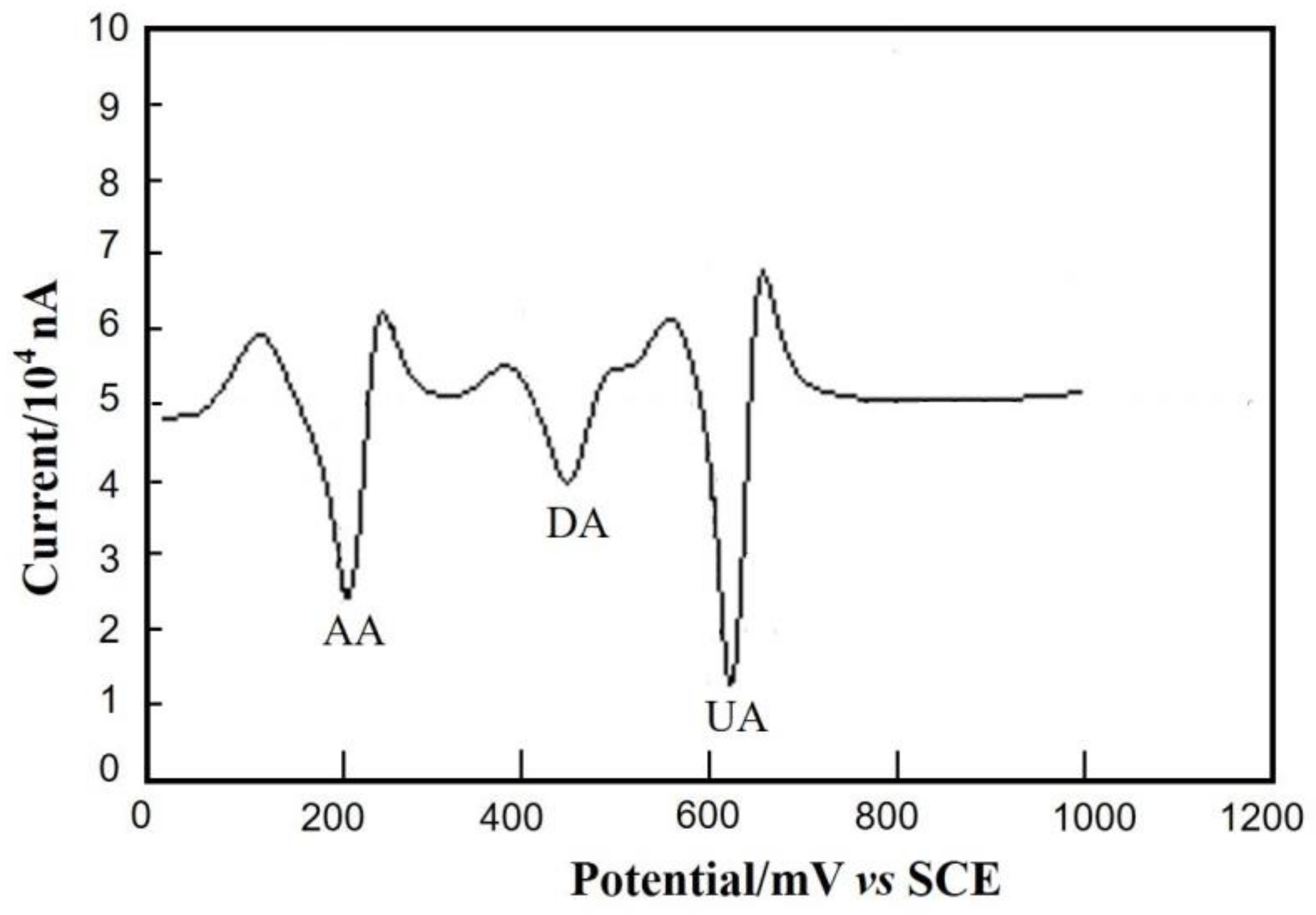

| Modified Electrodes | Linear Range (M) | Detection Limit (M) | Ref. |
|---|---|---|---|
| NH2–Fe3O4/RGO/GCE | 1 × 10−8~1 × 10−7; 1 × 10−7~1 × 10−6; 1 × 10−6~1 × 10−5 | 4.0 × 10−9 | This work |
| Fe3O4–NH2@GS/GCE | 2 × 10−7~3.8 × 10−5 | 1.26 × 10−7 | [24] |
| Cu2O/RGO/GCE | 1 × 10−8~1 × 10−6; 1 × 10−6~8 × 10−5 | 6.0 × 10−9 | [35] |
| Pd/RGO/GCE | 1 × 10−6~1.5 × 10−4 | 2.3 × 10−7 | [47] |
| Fe3O4@Au/Gr/GCE | 5 × 10−7~5 × 10−5 | 6.5 × 10−7 | [48] |
| Fe3O4/RGO/CPE | 2 × 10−8~5.8 × 10−6 | 6.5 × 10−9 | [49] |
| MWCNT/RGO/GCE | 2 × 10−7~4 × 10−4 | 2.2 × 10−8 | [50] |
| Mn3O4–RGO/GCE | 1 × 10−6~1.45 × 10−3 | 2.5 × 10−7 | [51] |
| MnO2–RGO/GCE | 6 × 10−8~1× 10−3; 1 × 10−6 ~8 × 10−5 | 1.0 × 10−9 | [52] |
| MnO2 NR/RGO/GCE | 5 × 10−8 ~ 4 × 10−4 | 1.0 × 10−8 | [53] |
| No. | Standard Value (μM) | Determination Value (μM) | Added (μM) | Total Found (μM) | Recovery (%) | RSD (%) |
|---|---|---|---|---|---|---|
| 1 | 13.14 | 12.85 | 10.00 | 23.24 | 103.9 | 2.20 |
| 2 | 27.63 | 27.18 | 30.00 | 56.85 | 98.9 | −1.63 |
| 3 | 48.62 | 49.21 | 50.00 | 97.74 | 97.1 | 1.21 |
© 2018 by the authors. Licensee MDPI, Basel, Switzerland. This article is an open access article distributed under the terms and conditions of the Creative Commons Attribution (CC BY) license (http://creativecommons.org/licenses/by/4.0/).
Share and Cite
He, Q.; Liu, J.; Liu, X.; Li, G.; Chen, D.; Deng, P.; Liang, J. Fabrication of Amine-Modified Magnetite-Electrochemically Reduced Graphene Oxide Nanocomposite Modified Glassy Carbon Electrode for Sensitive Dopamine Determination. Nanomaterials 2018, 8, 194. https://doi.org/10.3390/nano8040194
He Q, Liu J, Liu X, Li G, Chen D, Deng P, Liang J. Fabrication of Amine-Modified Magnetite-Electrochemically Reduced Graphene Oxide Nanocomposite Modified Glassy Carbon Electrode for Sensitive Dopamine Determination. Nanomaterials. 2018; 8(4):194. https://doi.org/10.3390/nano8040194
Chicago/Turabian StyleHe, Quanguo, Jun Liu, Xiaopeng Liu, Guangli Li, Dongchu Chen, Peihong Deng, and Jing Liang. 2018. "Fabrication of Amine-Modified Magnetite-Electrochemically Reduced Graphene Oxide Nanocomposite Modified Glassy Carbon Electrode for Sensitive Dopamine Determination" Nanomaterials 8, no. 4: 194. https://doi.org/10.3390/nano8040194
APA StyleHe, Q., Liu, J., Liu, X., Li, G., Chen, D., Deng, P., & Liang, J. (2018). Fabrication of Amine-Modified Magnetite-Electrochemically Reduced Graphene Oxide Nanocomposite Modified Glassy Carbon Electrode for Sensitive Dopamine Determination. Nanomaterials, 8(4), 194. https://doi.org/10.3390/nano8040194






